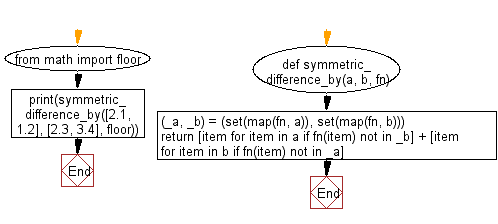Python: Symmetric difference between two lists, after applying the provided function to each list element of both
Symmetric Difference with Function
Write a Python program to get the symmetric difference between two lists, after applying the provided function to each list element of both.
- Create a set by applying fn to each element in every list.
- Use a list comprehension in combination with fn on each of them to only keep values not contained in the previously created set of the other.
Sample Solution:
Python Code:
# Define a function 'symmetric_difference_by' that takes two lists 'a' and 'b' and a function 'fn' as input.
def symmetric_difference_by(a, b, fn):
# Create sets '_a' and '_b' containing the results of applying the 'fn' function to each element in 'a' and 'b'.
(_a, _b) = (set(map(fn, a)), set(map(fn, b)))
# Find the elements in 'a' that are not in '_b' and the elements in 'b' that are not in '_a'.
# Combine these two sets and return the result as a list.
return [item for item in a if fn(item) not in _b] + [item for item in b if fn(item) not in _a]
# Import the 'floor' function from the 'math' module.
from math import floor
# Display the result of applying 'symmetric_difference_by' to two example lists using the 'floor' function.
print(symmetric_difference_by([2.1, 1.2], [2.3, 3.4], floor))
Sample Output:
[1.2, 3.4]
Flowchart:

For more Practice: Solve these Related Problems:
- Write a Python program to compute the symmetric difference between two lists after converting all elements to strings.
- Write a Python program to get the symmetric difference of two lists using a custom function that normalizes numeric values.
- Write a Python program to find the symmetric difference between two lists after applying a function that extracts the first character from each element.
- Write a Python program to calculate the symmetric difference between two lists and return the result sorted in descending order after transformation.
Go to:
Previous: Write a Python program to get a list of elements that exist in both lists, after applying the provided function to each list element of both.
Next: Write a Python program to get every element that exists in any of the two given lists once, after applying the provided function to each element of both.
Python Code Editor:
What is the difficulty level of this exercise?
Test your Programming skills with w3resource's quiz.
